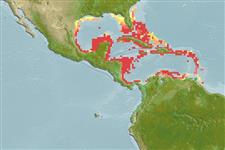>
Kurtiformes (Nurseryfishes, cardinalfishes.) >
Apogonidae (Cardinalfishes) > Apogoninae
Etymology: Apogon: Greek, a = without + Greek pogon = chin, beard (Ref. 45335).
More on author: Poey.
Environment: milieu / climate zone / depth range / distribution range
Ecologia
marino associati a barriera corallina; distribuzione batimetrica 1 - 60 m (Ref. 9626). Tropical; 32°N - 9°N
Western Central Atlantic: Bermuda, southeastern Florida (USA), and Bahamas to the Antilles (Ref. 26340) and Venezuela.
Size / Peso / Age
Maturity: Lm ? range ? - ? cm
Max length : 13.0 cm SL maschio/sesso non determinato; (Ref. 26938)
Ubiquitous, from gravel pits and rock ledges at the sea's edge to clear-water reefs. Remains hidden in cracks and crevices during the day (Ref. 9626). Sometimes observed between the spines of Diadema antillarum (Ref. 9626).
Life cycle and mating behavior
Maturità | Riproduzione | Deposizione | Uova | Fecundity | Larve
Mouthbrooders (Ref. 240). Distinct pairing during courtship and spawning (Ref. 205).
Robins, C.R. and G.C. Ray, 1986. A field guide to Atlantic coast fishes of North America. Houghton Mifflin Company, Boston, U.S.A. 354 p. (Ref. 7251)
IUCN Red List Status (Ref. 130435: Version 2024-2)
Threat to humans
Harmless
Human uses
Strumenti
Special reports
Download XML
Fonti Internet
Estimates based on models
Preferred temperature (Ref.
123201): 25.3 - 28, mean 26.8 °C (based on 176 cells).
Phylogenetic diversity index (Ref.
82804): PD
50 = 0.5000 [Uniqueness, from 0.5 = low to 2.0 = high].
Bayesian length-weight: a=0.01096 (0.00469 - 0.02561), b=3.08 (2.90 - 3.26), in cm total length, based on LWR estimates for this Genus-body shape (Ref.
93245).
Trophic level (Ref.
69278): 3.4 ±0.45 se; based on food items.
Resilienza (Ref.
120179): Alto, tempo minimo di raddoppiamento della popolazione meno di 15 mesi (Preliminary K or Fecundity.).
Fishing Vulnerability (Ref.
59153): Low vulnerability (10 of 100).
Nutrients (Ref.
124155): Calcium = 107 [69, 183] mg/100g; Iron = 0.969 [0.626, 1.497] mg/100g; Protein = 18.8 [17.7, 19.7] %; Omega3 = 0.167 [0.105, 0.263] g/100g; Selenium = 29.4 [17.1, 52.7] μg/100g; VitaminA = 153 [60, 394] μg/100g; Zinc = 1.62 [1.14, 2.21] mg/100g (wet weight);
